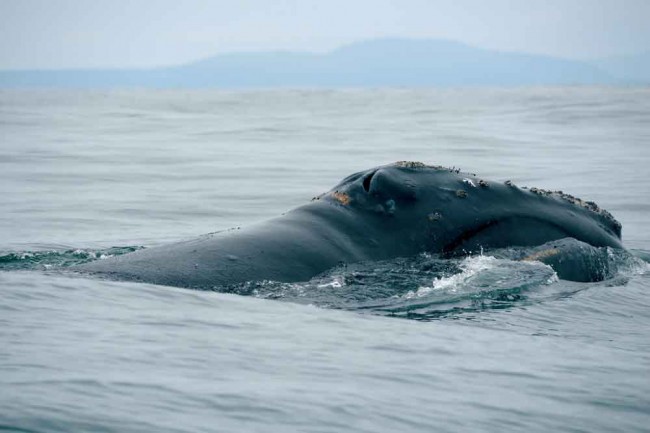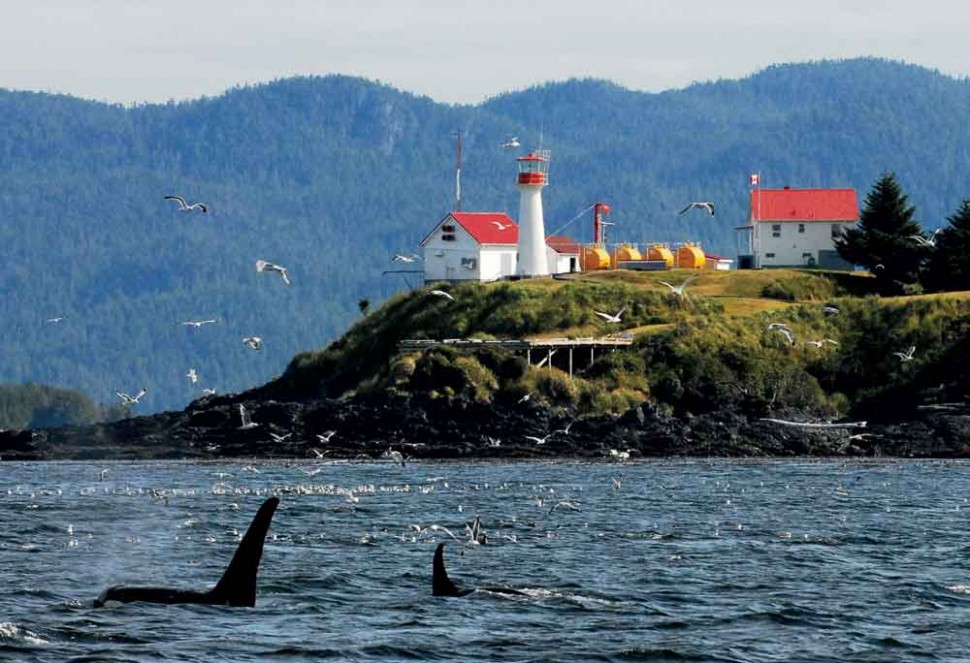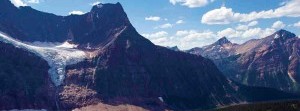
Photo Credit: Fisheries and Oceans Canada
Cetaceans & citizen science in the North
Phooooouuuuuuughhhhhht.
A humpback whale exhales. Its loud breath is accompanied by a near-simultaneous shriek from two young girls watching from the upper deck of Prince Rupert Adventure Tours’ wildlife-watching vessel the MV Inside Passage. While more subdued than the youngsters, several adults also let out an audible gasp as the school-bus-sized animal surfaces again. After four breaths, the whale arches its behemoth back and its huge tail rises out of the water as it slips beneath the surface of Chatham Sound. The entire boat lets out a collective, awed sigh.
What is it about cetaceans (the collective term for whales, dolphins and porpoises) that is so captivating to humans? In Prince Rupert, there are no fewer than five buildings decorated with giant whale murals, a grey whale statue standing proudly at the waterfront and numerous shops selling souvenirs festooned with whale images.
John Ford, who has been studying whales since the 1970s and is now head of Fisheries and Oceans Canada’s Pacific Cetacean Research Program, answers with a laugh: “They’re big?”
He elaborates: “When you first see a big whale you can’t help but be impressed. You know you’re just seeing the tip of the iceberg and when you’re close enough to hear their echoing breath—that hollow-cave sound—you just know that these are huge animals. They have inherent mystery to them.”
Counting for conservation
North coast citizens and mariners are being asked to take this fascination and turn it into useful data. While immensely popular, there are many questions still to be answered about the icons of the sea, especially on the less-inhabited, less-frequently-studied north coast.
For more than a decade, the Vancouver Aquarium, in collaboration with DFO, has coordinated the BC Cetacean Sightings Network. The program engages a wide variety of coastal residents, recreational boaters, professional mariners and others to act as citizen scientists by reporting their sightings of whales, dolphins, porpoises and sea turtles throughout BC.
While observers from across the coast have contributed over the years (compiling nearly 80,000 records), the majority of participation and data comes from the south coast. To rectify this data gap in the North, in early 2014 the Vancouver Aquarium established its North Coast Field Office to, among other things, encourage increased participation in the Sightings Network.
“The data we collect through the Sightings Network allow researchers to better understand the distribution and occurrence of cetaceans,” BC Cetacean Sightings Network coordinator Tessa Danelesko explains. “Eleven cetacean populations found in BC are listed at-risk under Canada’s Species at Risk Act. Knowledge of when and where they spend time is key to better protect and manage these populations. We want to make sure we are collecting data from everywhere on the coast, including the North.”
The north coast is a special area for cetaceans. Seventeen species have been recorded in these waters, including some that have teetered on the brink of extinction. Many large whale species were heavily hunted throughout the North Pacific well into the 20th century. Some species have rebounded well. According to Ford, in the North “the density of large whales—fin whales, humpback whales particularly—is greater than anywhere else on the coast.”
Other species have not rebounded, but this area offers a small glimmer of hope. Last year, for the first time in 62 years, a North Pacific right whale was spotted off the west coast of Haida Gwaii. Scientists estimate there are fewer than 50 of these animals left in the entire world. While Ford warns that this sighting may have been a mere coincidence, it is still some cause for cautious optimism: “I like to think it’s a sign that there is some hope for them.”
Born in the North
While the BC Cetacean Sightings Network’s head office is at the Vancouver Aquarium and its new satellite office is in Prince Rupert, this program actually has its roots in Haida Gwaii. In the early ’90s, Ford, then working for the aquarium, was commissioned by Parks Canada to conduct a cetacean species inventory in what is now Gwaii Haanas. On top of doing fieldwork, he recruited marine wildlife viewing tour operators to begin recording and reporting their sightings.
“We recognized that this approach could yield good data and we expanded the program to include more of the coast,” Ford explains. Thus, the BCCSN and its citizen science approach were born.
Citizen science is defined as “projects in which volunteers partner with scientists to answer real-world questions” by the Cornell Lab of Ornithology, which runs some of the largest and most successful citizen science projects in the world. By using the extensive numbers, experience and geographical range of citizens, scientists can tap into a wealth of information. To date, over 4,000 people have reported sightings to the network.
Renata Neftin is one of these observers. She works as a relief lighthouse keeper throughout the coast, most often in the North near her Prince Rupert home. Since 2009, she has submitted cetacean sightings from her vantage point on the lights. In the North, she mainly sees humpback whales; just because they are common, doesn’t mean they aren’t exciting to observe.
“One of the more fascinating moments happened at Triple Island, where I was able to watch eight, yes, eight humpback whales bubble netting together,” Neftin says, describing a behaviour commonly observed only in BC’s northern waters. “It is an incredible feat of cooperation and teamwork for eight whales to make a bubble net together and coordinate their timing to scoop up whatever they were feeding on.”
At a time when funding for scientific research is tight, citizen science offers a cost-effective and wide-reaching way of collecting large amounts of data.
“It’s also a way to engage people in the scientific process and get them involved,” Danelesko explains. “By being involved, they become invested and interested in the species they are recording. Our observers are not only the eyes and ears of the coast, but they also become stewards.”
Marty and Mae Jong Bowles are two of these citizen scientist stewards. Eight years ago they purchased their 30-foot sailboat Wild Abandon. Their passion for adventure and exploring the coast led them to become observers for the BCCSN.
“When we heard about the project, we knew we had to get a logbook,” Mae recounts. “When we are out on the water, we’re so lucky to see so much. We know how important it is to document what’s out there, to show the importance of an area and ecosystem.”
In four years, they’ve recorded 250 sightings for the program.
Discoveries and recoveries
The time is right to learn as much as possible about the whales that make this region home. Improving baseline knowledge and monitoring can only bode well for cetaceans in the face of increased industry for the region.
“This data helps us understand where the hot spots are,” Ford explains. The sightings can be used to better pinpoint areas of critical habitat or regions that require more study. For example, scientists only recently discovered that nearly all 20,000 grey whales that migrate through BC to the Bering Sea pass through Hecate Strait and not the west side of Haida Gwaii as previously thought. “Understanding patterns such as these is important for understanding how human activities may affect whales.
“Whales have survived a lot of abuse by humans,” he adds. “They are icons for a lot of the wrongs we’ve done to oceanic animals. They are survivors. I think people are happy they’re there, that they’ve come back.”
Now, north coasters are being encouraged more than ever to contribute their observations to better understand these intriguing creatures.
Contribute sightings to the BC Cetacean Sightings Network online at wildwhales.org, toll-free at 866-I SAW ONE or via email, sightings@vanaqua.org. Logbooks are available upon request.














